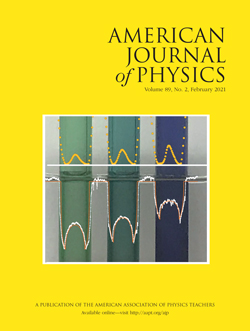 February 2021 Issue,
February 2021 Issue,
Volume 89, No. 2
Index matching computerized tomography
Computerized tomography (CT) has been used for decades by medical professionals to detect and diagnose injuries and ailments. CT scanners are based on interesting physics, but due to their bulk, cost, and safety, hands on experience with a medical CT scanner are unrealistic for undergraduate students. Therefore, operationally similar, yet small, safe, and inexpensive CT scanners are desirable teaching tools. This project details the development of a novel model CT scanning apparatus. The experimental setup presented utilizes visible light, has short data acquisition time, and operates on the same physics as its X-ray counterpart. The apparatus employs a laser and photodiode to image a transparent material, while avoiding loss of transmitted intensity through index of refraction matching. A simple back-projection algorithm results in a 2D cross section of the scan object. We found we could collect data and reliably image samples in 15 min.
EDITORIAL
In this issue: February 2021 by Beth Parks. DOI: 10.1119/10.0003197
PAPERS
On levitation by blowing by Paul K. Newton and Y. Ma. DOI: 10.1119/10.0002032
This very readable paper explores the seemingly simple question of how to most efficiently bring a ball into levitation at a constant height by blowing it upwards, allowing instructors to easily introduce control theory into an upper-level mechanics course.
Bouncing on a slope by Rouben Rostamian, Ana Maria Soane and José M. Tavares. DOI: 10.1119/10.0002099
Analyzing the motion of a ball sent bouncing uphill on a slanted surface yields surprising results. For example, the time intervals between all the bounces are equal. This paper uses introductory-level mechanics to analyze the motion, in the limit that the rebound is perfectly elastic.
Investigating t∞ for bouncing balls by Paul J. Hatchell. DOI: 10.1119/10.0002435
Real collisions between a ball and a surface are not elastic, and if a ball loses a fixed fraction of its energy on each bounce, then theoretically it will bounce infinitely many times in a finite time interval before coming to rest. In this paper, the physics of a bouncing ball is investigated using sound. Correlation and deconvolution are used to pick out the bounce times, and examples are given showing good agreement between real data and the model prediction. Appropriate for students of all levels.
Basics of sound in air: Correspondence with electromagnetic waves by Ulrich Zürcher. DOI: 10.1119/10.0002050
Physics classes often teach sound waves at an introductory level, but then never revisit them to add more detail, resulting in many of us having a very incomplete picture of sound waves. This paper points out analogies between sound waves and electromagnetic waves and uses them to answer the questions: (1) what is actually moving in the sound wave? and (2) what are the potential and kinetic energies involved in sound wave propagation?
d'Alembert digitized: A wave pulse method for visualizing electromagnetic waves in matter and for deriving the finite difference time domain method for numerically solving Maxwell's equations by Ross Hyman, Nathaniel P. Stern and Allen Taflove. DOI: 10.1119/10.0002038
A discretized version of d'Alembert's method of splitting waves into forward and backward pulses is used to solve Maxwell's equations for one-dimensional problems. Several examples are considered, including the propagation of electromagnetic waves in layered dielectric materials and conductors. Appropriate for advanced E&M classes.
Introducing SU(3) color charge in undergraduate quantum mechanics by Brandon L. Inscoe and Jarrett L. Lancaster. DOI: 10.1119/10.0002004
The meaning and manipulation of color charge and SU(3) is developed by analogy with spins and SU(2). VPYTHON is used for visualization of color charge dynamics. The paper is accessible to advanced undergraduates, and can be used for independent student projects.
Length as a paradigm for understanding the classical limit by Mark G. Kuzyk. DOI: 10.1119/10.0002180
Using simple physical constraints, an expression for the classical length is proposed. This expression is generalized to the quantum realm by replacing material density with probability density. The many-particle results converge to the classical length, but the quantum behavior–with the breakdown of one-to-one correspondence and evaporating rulers–challenges our intuition.
Boosting vector calculus with the graphical notation by Joon-Hwi Kim, Maverick S. H. Oh and Keun-Young Kim. DOI: /10.1119/10.0002142
A graphical representation is described for vector algebra and calculus, and examples are given in physics contexts. This approach can supplement teaching math and physics at the intermediate undergraduate level.
INSTRUCTIONAL LABORATORIES AND DEMONSTRATIONS
Spatial structuring of light for undergraduate laboratories by Sergei Panarin, Jonas Müller, Shashi Prabhakar and Robert Fickler. DOI: 10.1119/10.0002365
Digital micromirror devices can replace more traditional spatial light modulators used in experiments in the undergraduate lab ranging from multi-slit diffraction to optical Fourier transformations. They can also be used to create Laguerre-Gaussian beams used to study orbital angular momentum of light.
Index matching computerized tomography by Vincent Daley, Owen Paetkau and Mark Paetkau. DOI: 10.1119/10.0002410
A novel apparatus allows students to learn the principles of CT scans while working with visible light, making the apparatus both safer and cheaper than its x-ray counterpart that is used in medical imaging.
BACK OF THE ENVELOPE
When to postpone approximating: The Rule of 69.3ish by Sanjoy Mahajan. DOI: 10.1119/10.0002886
Long ago I learned the handy “Rule of 70” to convert between growth rates and doubling time. It turns out that there’s a lot of interesting math in the rule, if you dig in a little. Enjoy!
BOOK REVIEWS
A Student's Guide to the Schrödinger Equation by David Derbes. American Journal of Physics 89, 227 (2021); https://doi.org/10.1119/10.0001532
About AJP
General Information, Resources for Authors, Reviewers, and Readers

